Piano Keyboard Diagram - Layout Of Keys With Notes
In this lesson we will take a look at various piano keyboard diagrams. We will learn all about the layout of keys on the 88 key piano as well as keyboards with less keys.
We will look at 88-key, 76-key, 61-key, 49-key, 37-key, 36-key and 32-key keyboards. Sounds like a lot of keyboards, but the principle behind the layout of keys on every piano keyboard is the same. If you know the layout of keys on a piano, it doesn't matter how many keys your keyboard has, the layout of keys are similar.
Here's a blank piano keyboard diagram. This one has only 36 keys.

Here's another 36-key diagram/keyboard layout.

Do you see how the white keys are labeled? It's really the same 7 notes being repeated over and over. These are all the notes of the musical alphabet, and these notes are A, B, C, D, E, F, G.
Highly Recommended: Go here for the BEST piano/keyboard course I’ve seen on the Internet.
When one first looks at a piano, the keys can seem overwhelming. But in fact, it's not. It's the same pattern of keys being repeated. No matter how many keys your keyboard comes with, this is the note pattern of the white keys on a piano.
So how about the black keys? I want you to notice something else about the pattern of keys on your keyboard. If you take a good look at the black keys you will realize that it's a pattern of a set of two black keys followed by a set of three black keys, followed by two black keys, followed by three black keys and so on. This keeps repeating depending on the number of keys that your keyboard or piano has.
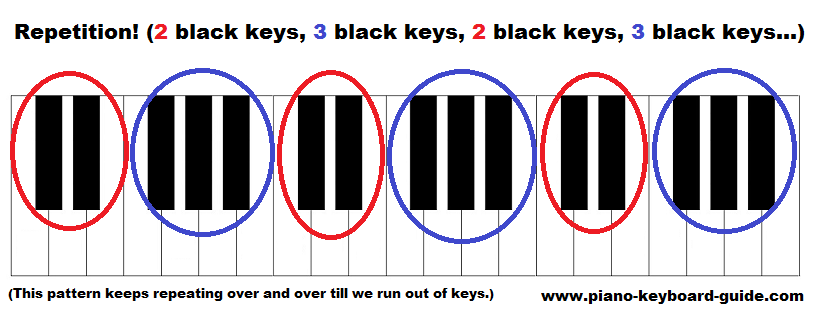
Let's label the black keys. Each black key in the piano keyboard diagram below has two note names. There's D-Flat (or C-Sharp), E-Flat (or D-Sharp), G-Flat (or F-Sharp), A-Flat (or G-Sharp) and B-Flat (or A-Sharp).
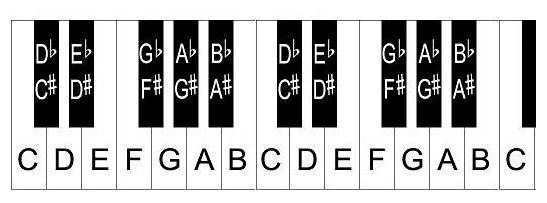 Piano keyboard diagram, layout of keys and notes.
Piano keyboard diagram, layout of keys and notes.What does sharp and flat really mean? To help you understand this better let's talk for a moment about what is known as a semitone. A semitone is also called a half step or half tone and is the smallest interval in Western music. It is the distance between two notes which are next to each other in pitch. For example, the distance between C and C sharp is a semitone. The distance between D and D Flat is also a semitone.
The note which is one semitone higher than C is C sharp. On piano, this is the black key to the immediate right of C. The note which is one semitone lower than D is D flat. On piano, this is the black key to the immediate left of D. But isn't this the same key? Why do they have different names, you might ask. There's a term used to describe this and it's called enharmonics. C sharp and D flat are enharmonic equivalents because while they are played by the same key, they have different note names. Sharp means that the note is a semitone higher, while flat means that it's a semitone lower.
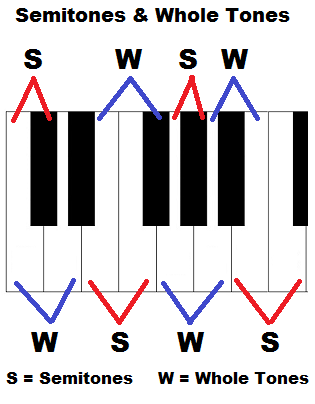
Notes can also be a whole tone apart. For instance D is a whole tone higher than C. C is a whole tone lower than D. E is a whole tone higher than D. D is a whole tone lower than E. And so on. A whole tone is a distance of two semitones.
It's really only 12 keys being repeated over and over on a piano. A 12-key pattern. Don't let a piano's many keys overwhelm you. It's really that simple. These 12 keys consist of 7 white keys and 5 black keys. And that's all. As we saw earlier the 12 notes are C, C-Sharp (or D-Flat), D, D-sharp (or E-Flat), E, F, F-Sharp (or G-Flat), G, G-Sharp ( or A-Flat), A, A-Sharp (or B-Flat), and B.
Take a look at the pattern of two and three black keys once again. You will notice that the note, C always comes before a group of two black keys, while F always comes before a group of three black keys.
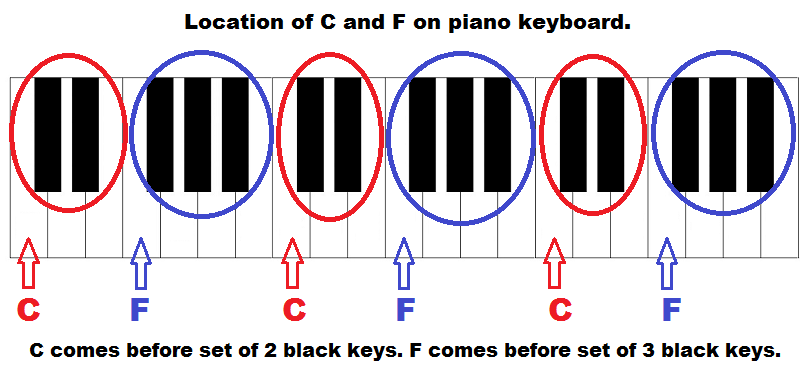
This takes us to a note or key that is very important when learning to play the piano. This note or key is Middle C. As the term middle C suggests, on piano or keyboard, middle C lies around the middle of your keyboard. In music notation, middle C is in the center of the grand staff, between the treble and bass staves (which is plural for staff).
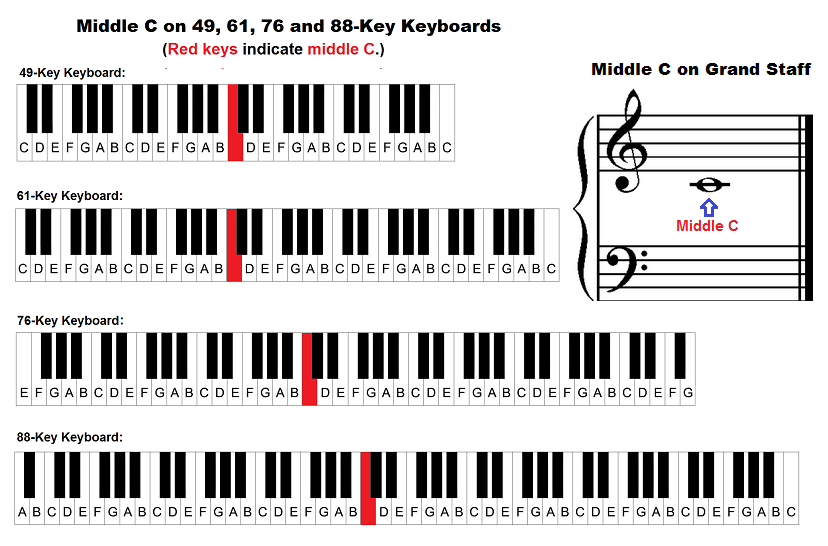
Piano Keyboard Diagrams - 32, 37, 49, 54, 61, 76 and 88 Key
Let's now take a look at different piano keyboards, each with a different number of keys. Please note that while an 88 key piano or keyboard starts with the note, A, other keyboards start with either C, E or F.
Here are two 32 key keyboards. One starts with C while the other starts with the note F.
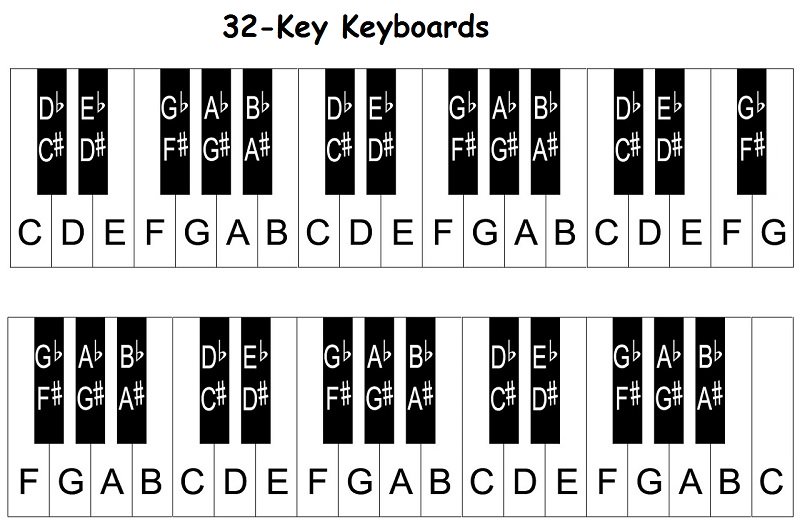
Here are two 36 key piano keyboard diagrams. Likewise, one starts with C while the other starts with the note F.
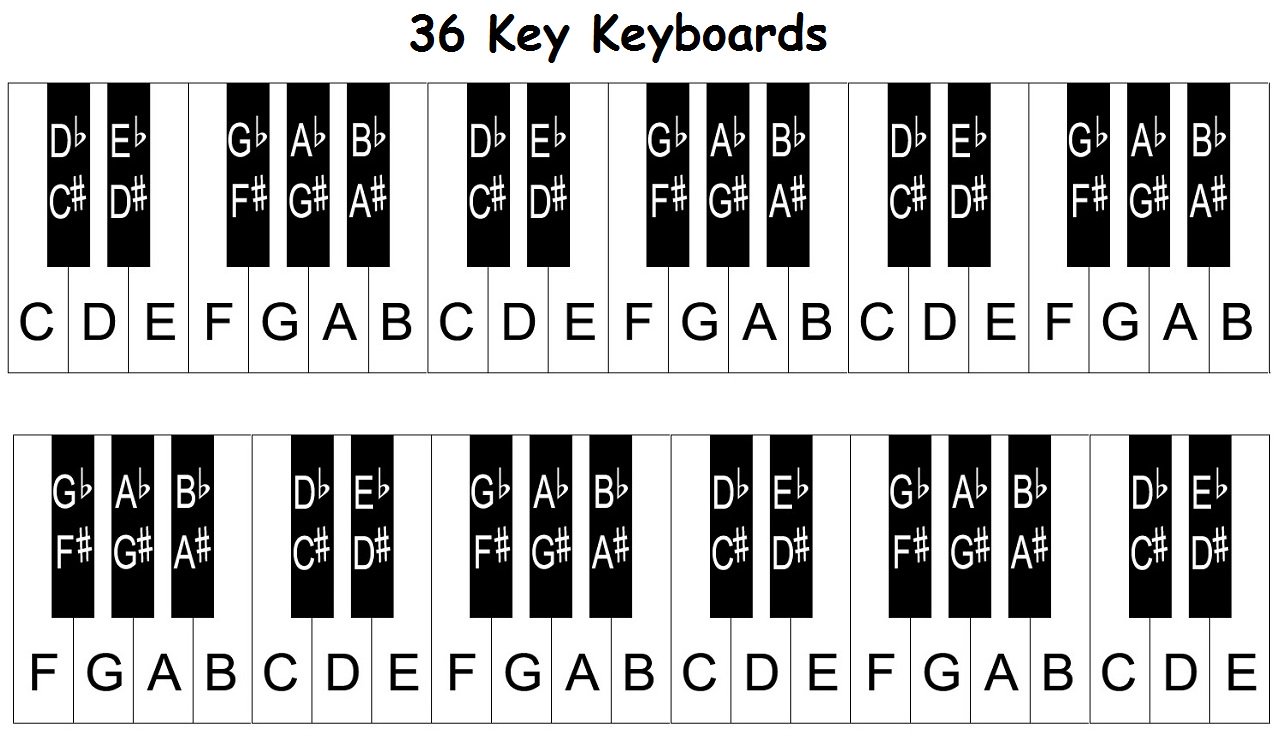
Here are two 37 key keyboards. Similarly, one starts with C while the other starts with the note F.
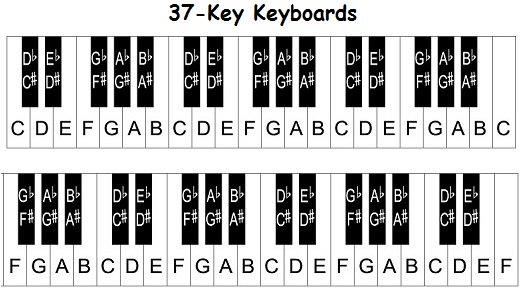
This takes us to a 49 key keyboard. 49 key keyboards usually start with the note, C. Also the last note on this keyboard is C. On a 49 key keyboard, there are 5 C's.

Here's a 54 key piano keyboard diagram. Like 49 key keyboards, this keyboard starts with the note, C. But it ends with the note, F.

61-key keyboards start on C as well. They start on C and end on C. There are 6 C's on this keyboard.

The first note on a 76 key keyboard is E. The last note is G. There are 6 C's on this keyboard.

And as we said earlier, the 88 key piano starts with the note A. The last note on an 88-key keyboard is C. There are 8 C's on an acoustic piano or 88 key digital piano or keyboard.

If you understand the 12-key pattern on a piano keyboard, you will have no problem labelling any keyboard. It's all about repetition!
There is really no difference in labeling any keyboard no matter how many keys it has. What you need to do is to recognize that there are two black keys then a gap with no black key, then 3 black keys, a gap with no black key, then 2 black keys, and the pattern keeps repeating over and over. If you keep this picture in mind, it will help you remember the notes on your keyboard.
I trust that you have a clearer understanding on this topic (Piano Keyboard Diagram/Layout) and know how to label the keys on a piano keyboard.
Search This Site:

Recommended For You
Learn to play piano and keyboards:
Click here to learn how to play keyboards and piano (with Piano For All).
Go here to buy a Yamaha keyboard.
Check out How To Read Music Fast: A 4-Step Beginner's Guide To Reading Music Quickly And Easily.





New! Comments
Have your say about what you just read! Leave me a comment in the box below.